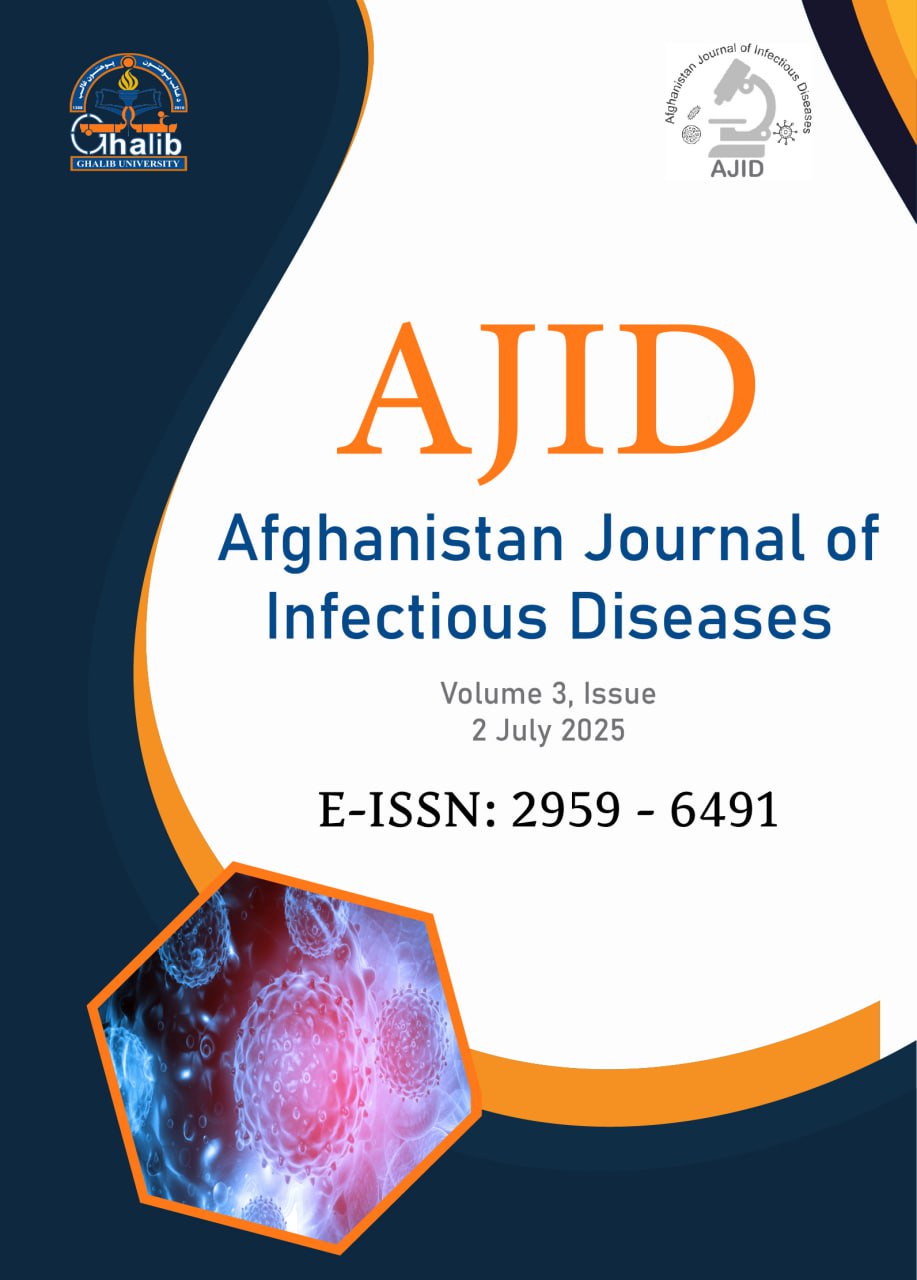Dynamics-Informed Neural Network Modeling of COVID-19 Transmission in Afghanistan Using the SEIR-V Framework
Main Article Content
Abstract
Background: The COVID-19 pandemic posed significant challenges for public health systems globally, particularly in resource-limited settings such as Afghanistan. Limitations in diagnostic capacity, inconsistent data reporting, and low vaccination coverage hindered timely public health responses. To support real-time decision-making, accurate and adaptive modeling frameworks are essential.
Methods: This study presents a hybrid modeling approach that integrates the classical SEIR-V (Susceptible–Exposed–Infectious–Recovered–Vaccinated) compartmental model with Dynamics-Informed Neural Networks (DINNs). The model embeds the SEIR-V system of differential equations into the loss function of a deep neural network to enable dynamic estimation of time-varying parameters. Epidemiological data from Feb 2020 to Apr 2024 were collected from multiple publicly available sources, including Worldometer, Our World in Data, the World Health Organization and the Johns Hopkins University COVID-19 repository.
Results: The proposed DINNs-SEIRV model effectively reconstructed multiple epidemic waves and generated accurate forecasts of COVID-19 transmission dynamics in Afghanistan. The model achieved high predictive performance, particularly for the infectious (I) compartment, with a coefficient of determination R² = 0.9973. It also demonstrated strong capacity in capturing vaccination trends and maintaining robustness in the presence of incomplete or noisy data.
Conclusion: The DINNs-SEIRV framework offers a powerful and flexible tool for modeling infectious disease dynamics in low-resource settings. Its ability to learn and update time-varying parameters in response to real-world data makes it valuable for informing public health strategy, forecasting outbreaks, and evaluating vaccination efforts in environments like Afghanistan
Article Details

This work is licensed under a Creative Commons Attribution 4.0 International License.
References
Worldometer. COVID-19 Coronavirus Pandemic – Afghanistan. Available at: https://www.worldometers.info/coronavirus/country/afghanistan/
Hethcote HW. The mathematics of infectious diseases. SIAM Rev. 2000;42(4):599–653.
Giordano G, Blanchini F, Bruno R, et al. Modelling the COVID-19 epidemic and implementation of population-wide interventions in Italy. Nat Med. 2020;26:855–860.
Abolpour R, Siamak S, Mohammadi M, et al. Linear parameter varying model of COVID-19 pandemic exploiting basis functions. Biomed Signal Process Control. 2021;70:102999.
Roda WC, Varughese MB, Han D, Li MY. Why is it difficult to accurately predict the COVID-19 epidemic? Infect Dis Model. 2020;5:271–281.
Hassan MH, El‐Azab T, AlNemer G, Sohaly MA, El-Metwally H. Analysis of time-delayed SEIR model with survival rate for COVID-19 stability and disease control. Mathematics. 2024;12(23):3697.
Ning X, Jia L, Wei Y, Li XA, Chen F. Epi-DNNs: Epidemiological priors informed deep neural networks for modeling COVID-19 dynamics. Comput Biol Med. 2023;158:106693.
Cheng C, Aruchunan E, Noor Aziz MH. Leveraging dynamics informed neural networks for predictive modeling of COVID-19 spread: A hybrid SEIR-V-DNNs approach. Sci Rep. 2025;15:2043.
Alshanbari HM, Arif M, Khan MA, et al. Forecasting COVID-19 deaths using artificial neural networks and time-series models: Evidence from Pakistan. Diagnostics. 2023;13(6):1310.
Watson OJ, Barnsley G, Toor J, et al. Global impact of the first year of COVID-19 vaccination: a mathematical modelling study. Lancet Infect Dis. 2022;22(9):1293–1302.
He M, Tang S, Xiao Y. Combining the dynamic model and deep neural networks to identify the intensity of interventions during COVID-19 pandemic. PLoS Comput Biol. 2023;19. https://doi.org/10.1371/journal.pcbi.1011535
Liu D, Shahid M, Xu Z, et al. Optimizing deep neural networks to predict the effect of social distancing on COVID-19 spread. Comput Ind Eng. 2022;166:107970.
Our World in Data. Coronavirus in Afghanistan. 2024. Available at: https://ourworldindata.org/coronavirus/country/afghanistan
World Health Organization. Afghanistan COVID-19 Dashboard. Available at: https://www.who.int/countries/afg
Johns Hopkins University CSSE. Afghanistan COVID-19 Data. Available at: https://coronavirus.jhu.edu/region/afghanistan
United Nations Department of Economic and Social Affairs, Population Division. World Population Prospects 2022. Available at: https://population.un.org/wpp/
Han S, Stelz L, Stoecker H, Wang L, Zhou K. Approaching epidemiological dynamics of COVID-19 with physics-informed neural networks. J Franklin Inst. 2024;106671.
Wang H, Wu D, Luo J, Zhang J. Integrating socio-psychological factors in the SEIR model optimized by a genetic algorithm for COVID-19 trend analysis. Dent Sci Rep. 2024;14(1).
Sarin S, Singh SK, Kumar S, et al. SEIR‐driven semantic integration framework: Internet of Things‐enhanced epidemiological surveillance in COVID‐19 outbreaks using recurrent neural networks. IET Cyber Phys Syst. 2024. https://doi.org/10.1049/cps2.12091
Liu R, Li J, Wen Y, et al. Deep dynamic epidemiological modelling for COVID-19 forecasting in multi-level districts. arXiv. 2023. https://doi.org/10.48550/arXiv.2306.12457
Wang H, Qiu X, Li Q, et al. Neural-SEIR: A flexible data-driven framework for precise prediction of epidemic disease. Math Biosci Eng. 2023;20(9):16807–16823.
He M, Tang B, Xiao Y, Tang S. Transmission dynamics informed neural network with application to COVID-19 infections. Comput Biol Med. 2023.
Millevoi C, Pasetto D, Ferronato M. A physics-informed neural network approach for compartmental epidemiological models. arXiv. 2023. https://doi.org/10.48550/arxiv.2311.09944

